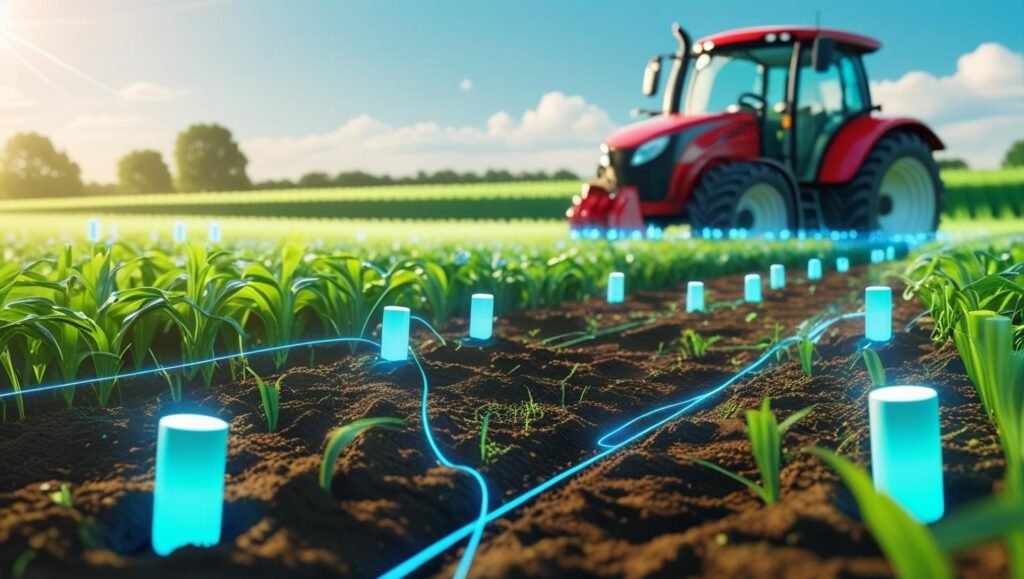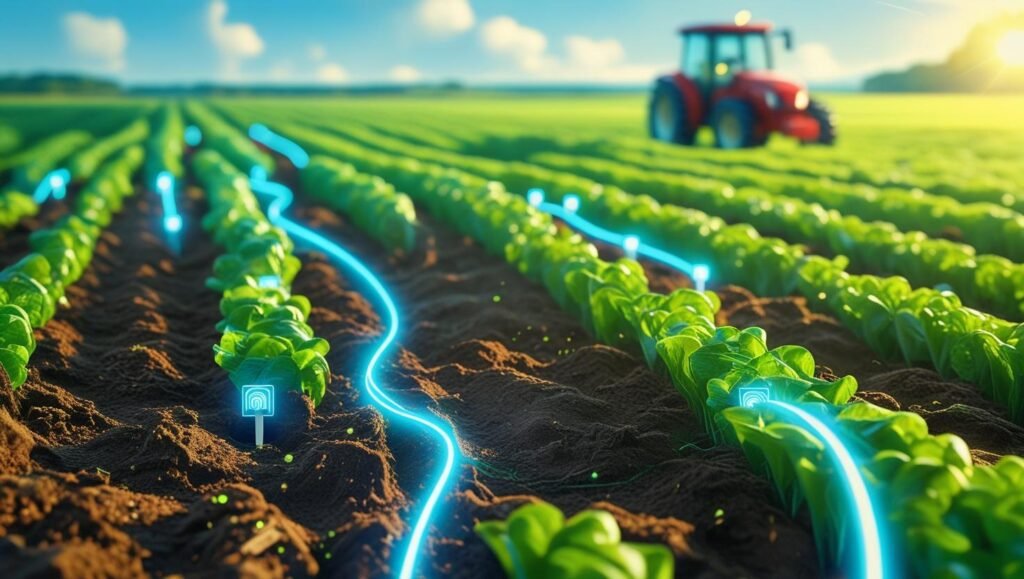Smart Farming Solutions to Save Water and Money Now

Water is precious, and for farmers, it’s the lifeblood of their crops. But with rising costs and unpredictable weather, saving water and money is tougher than ever. That’s where smart farming comes in, especially with IoT in agriculture. This technology uses connected devices to make farming smarter, helping farmers use less water while keeping crops healthy and costs low. In this blog, we’ll explore how IoT in agriculture works, why it’s a game-changer, and how farmers can start using it to save water and money now.
What Is IoT in Agriculture?
IoT, or the Internet of Things, is all about connecting devices to the internet so they can share information. In agriculture, this means using sensors, apps, and machines to monitor crops, soil, and weather. These tools send real-time data to farmers, helping them make better decisions. For example, IoT in agriculture can tell you exactly when your crops need water or if your soil is too dry, so you don’t waste resources.
This technology is simple to use and doesn’t require a tech degree. Farmers can check data on their phones or computers, making it easy to act fast. By using IoT, farmers save time, water, and money while growing healthier crops.
Why Farmers Need Smart Solutions Now
Farming isn’t easy. Droughts, rising water costs, and unpredictable weather make it hard to stay profitable. Wasting water means wasting money, and overwatering can harm crops. IoT in agriculture solves these problems by giving farmers precise control over their resources. Instead of guessing how much water to use, farmers get data to make smart choices. This means less waste, lower bills, and better harvests.
How IoT in Agriculture Saves Water
Water is one of the biggest expenses for farmers, but IoT in agriculture helps cut waste in clever ways. Here’s how:
1. Smart Sensors for Soil Monitoring
IoT sensors measure moisture levels in the soil. They tell farmers exactly when and where to water, so no drop is wasted. For example, if one part of a field is dry, the sensor alerts the farmer to water only that area. This precision saves water and keeps crops healthy.
2. Weather Tracking for Smarter Irrigation
IoT devices connect to weather stations to predict rain or dry spells. If rain is coming, the system can pause irrigation, saving water. This feature of IoT in agriculture ensures farmers only water when it’s needed, reducing waste and costs.
3. Automated Irrigation Systems
IoT-powered irrigation systems turn on and off automatically based on real-time data. These systems adjust water flow to match the needs of crops, preventing overwatering. Farmers can control everything from their phones, making it easy to save water without extra effort.
4. Leak Detection
Leaky pipes can waste thousands of gallons of water. IoT in agriculture uses sensors to detect leaks early, so farmers can fix them before they become costly. This simple fix saves water and prevents expensive repairs.
How IoT in Agriculture Saves Money
Saving water is great, but IoT in agriculture also cuts costs in other ways. Here’s how it helps farmers keep more money in their pockets:
1. Lower Water Bills
By using less water, farmers spend less on irrigation. IoT systems ensure every drop counts, so you’re not paying for water your crops don’t need. Over time, these savings add up, especially for large farms.
2. Reduced Energy Costs
Pumps and irrigation systems use electricity, which can get expensive. IoT in agriculture optimizes watering schedules, so pumps run only when necessary. This cuts energy use and lowers utility bills.
3. Better Crop Yields
Healthy crops mean more profit. IoT helps farmers avoid overwatering or underwatering, which can damage plants. By giving crops just the right amount of water, IoT in agriculture boosts yields and increases income.
4. Less Maintenance
IoT systems monitor equipment like pumps and pipes, catching problems early. This reduces repair costs and prevents breakdowns that could stop farming operations. Saving on maintenance means more money for other needs.

Real-World Examples of IoT in Agriculture
Farmers around the world are already using IoT in agriculture to save water and money. In California, a farmer used IoT sensors to cut water use by 25% during a drought, saving $10,000 in one season. In India, small farms use IoT apps to monitor soil moisture, doubling crop yields while using 30% less water. These success stories show how IoT in agriculture works for farms of all sizes.
Even beginners can start small with affordable IoT tools. For example, a basic soil sensor costs less than $100 and can connect to a free app. This makes IoT in agriculture accessible to everyone, from small family farms to large operations.
Getting Started with IoT in Agriculture
Ready to save water and money? Here’s how to start using IoT in agriculture today:
- Choose Simple Tools: Start with affordable IoT devices like soil moisture sensors or weather trackers. These are easy to install and use.
- Use a Mobile App: Most IoT systems come with apps that show data in real time. Download one that works with your sensors and check it daily.
- Start Small: Test IoT on one field or crop to see how it works. Once you’re comfortable, expand to other areas.
- Learn from Others: Join online farming communities to get tips from other farmers using IoT in agriculture.
- Ask for Help: Many IoT companies offer free support to help you set up and troubleshoot.
You don’t need to be a tech expert to use IoT. Most systems are designed for farmers, with simple instructions and user-friendly apps.
Challenges and Solutions
Like any new tool, IoT in agriculture has some challenges. Here’s how to handle them:
1. High Upfront Costs
Some IoT systems can be expensive to install. To save money, start with basic sensors and add more as you see savings. Many companies also offer payment plans.
2. Internet Access
IoT needs a stable internet connection, which can be tough in rural areas. Look for devices that work offline or use satellite connections to stay connected.
3. Learning Curve
New technology can feel overwhelming. Choose systems with simple apps and good customer support. Many companies offer free training to help you get started.
Why IoT in Agriculture Is the Future
The world is changing, and farming needs to keep up. With climate change and growing populations, saving water and money is more important than ever. IoT in agriculture makes farming sustainable by using resources wisely. It’s not just about saving money today—it’s about ensuring farms can thrive for years to come.
Farmers who adopt IoT now will stay ahead of the curve. They’ll save resources, grow better crops, and protect the environment. Plus, as IoT technology gets cheaper, it’s becoming easier for every farmer to use.
A Quick Comparison of IoT Tools
Here’s a simple table to help you choose the right IoT tools for your farm:
| Tool Type | Cost Range | Best For | Key Benefit |
|---|---|---|---|
| Soil Moisture Sensors | $50–$200 | Small to medium farms | Saves water by precise monitoring |
| Weather Trackers | $100–$500 | All farm sizes | Predicts rain to avoid watering |
| Automated Irrigation | $500–$2,000 | Medium to large farms | Automates watering to save time |
| Leak Detectors | $100–$300 | Farms with old pipes | Prevents water and money loss |
This table can guide you to the best IoT tools for your needs and budget.
Conclusion
IoT in agriculture is changing the way farmers work, making it easier to save water and money. With smart sensors, weather trackers, and automated systems, you can grow healthier crops while cutting costs. The technology is simple, affordable, and accessible, even for small farms. Start small, learn as you go, and watch your farm thrive. The future of farming is here—embrace IoT in agriculture and make every drop and dollar count.
FAQs
What is IoT in agriculture?
It’s technology that uses connected devices like sensors and apps to monitor crops, soil, and weather, helping farmers save water and money.
How much does IoT in agriculture cost?
Basic tools start at $50–$100, while advanced systems can cost $500 or more. Start small to keep costs low.
Do I need internet for IoT in agriculture?
Most systems need internet, but some work offline or with satellite connections for rural areas.
Can small farms use IoT?
Yes! Affordable sensors and apps make IoT in agriculture accessible for farms of all sizes.
Read more: Building Smart Cities with IoT: What’s Working Right Now




